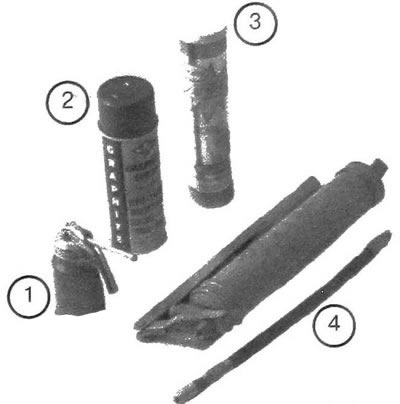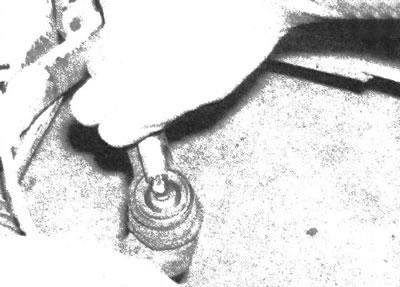
17.1. To lubricate the chassis elements, you will need the following materials and devices: 1. Engine oil - Must be in the oil can, which is used to lubricate the hood and door hinges; 2 Graphite grease in aerosol - Used to lubricate lock cylinders; 3. Grease - Refilled in the supercharger. There are several types of lubricant and are supplied in tubes of various sizes. Check the specifications for the type and amount of lubricant; 4. Grease pump (grease gun) - standard device. Illustrated with the hose disconnected and having a nozzle that aligns with the port connector when lubricating the chassis components. After use, requires immediate complete cleaning.
2. While under the car, determine the location of the holes for lubricant injection (see illustration).

17.2. After cleaning the inlet hole, place the blower tip on the fitting and press it in, then inject lubricant into the element (as a rule, about two injections are enough)
3. To provide the necessary access, lift the vehicle using a jack and place supports under the load-bearing frame elements. Make sure to ensure stability. If the procedure involves removing wheels to rotate or inspect brake system components, loosen the wheel nuts until the vehicle is lifted off the support surface.
4. Before lubricating the chassis components, release some grease from the supercharger, removing any dirt that may have accumulated on the tip. Wipe the tip with a clean cloth.
5. Keeping the supercharger ready and taking with you a sufficient amount of rags, proceed to lubricate the elements located on the bottom of the car.
6. Clean the hole fitting, place the tip on it and introduce lubricant from the supercharger by pressing the lever. Inject lubricant completely into the element. When lubricating the joint, pump in the lubricant until the boot hardens. Avoid over-injecting lubricant as this may damage the sealing elements.
Lubricant should be pumped into the remaining suspension and steering components before it begins to protrude between the articulated parts. If grease comes out of the tip when pumping, it should be assumed that the connector at the input hole is clogged or the tip is not seated tightly. Reconnect the tip and try pumping. Replace the connector if necessary.
7. Once lubrication is complete, wipe the surfaces of the parts and connector to remove excess lubricant. Perform the described procedure on each element with a hole for lubricant injection.
8. Clean the fittings and apply lubricant to the universal joints. Pump lubricant until it comes out of the joint contact points. Some universal joints are sealed and do not require lubricant to be pumped into them.
Note: Most replacement U-joints are not sealed and have grease fittings. If the driveline joints have been replaced, include them in the procedure for lubricating the chassis elements.
9. Also clean and lubricate the parking brake cable and levers.
Caution: Do not apply chassis lubricant to brake cables as the grease may damage the cable sheaths.
